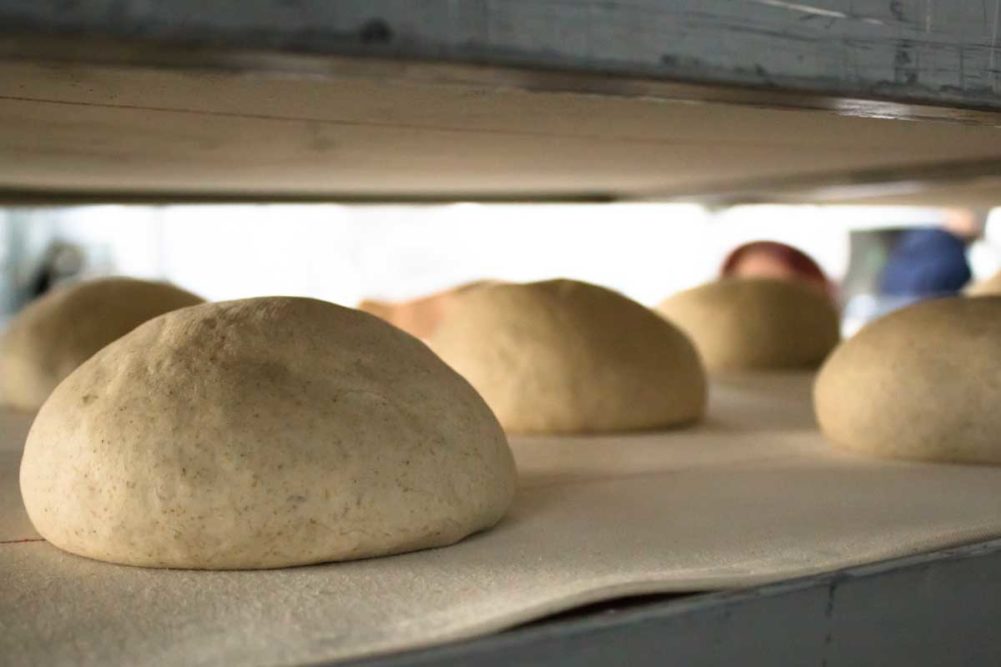For high-volume bakeries, focusing on a few fundamental artisan techniques can go a long way. Start by adding time and natural fermentation to the process.
“Almost any bakery can mix up a starter and begin adding it,” said Etai Baron, owner and chief executive officer of Izzio’s Artisan Bakery, Louisville, Colo.
Mr. Baron suggested peeling out artificial or unnecessary ingredients from formulas and, if it’s financially possible, switching to higher quality flours to accentuate flavor during the fermentation process.
Rachel Wyman, owner of Montclair Bread Co., understands space considerations may make extended fermentation difficult. In lieu of using traditional brioche that’s loaded with butter and ferments overnight, her Montclair, NJ-based bakery relies on a biga for a same-day brioche for her donuts that require a 24-hour process.
“We make pre-ferments from sourdough starters that take up less space than fermenting the whole dough in bulk, and you can move it through a process in eight hours,” she explained.
When commercial bakers condense the process, they lose the cell structure or flavor profiles that inspired the creation of an artisan bread.
“Baking based on time, temperature and humidity, that’s what sets the product apart,” said Rudy Abiera, R&D manager at Highland Baking Co, Northbrook, Ill. “When you do the long fermentation, you’re gaining flavor, you’re gaining strength, you’re producing natural yeast — all these are guidelines for making an artisan bread.”
However, sometimes the identity of an artisan bread can get lost in translation when trying to cut corners in the production process.
“They should ask themselves, ‘Can my formulas be produced by hand?’ ” noted Zach Martinucci, founder and “head rebel” at Rebel Bread in Denver. “If scaled back, could a plant foreman grab a kilogram of dough and produce the same thing without processes and machinery that humans can’t achieve?”
Yes, many artisanal bakers prefer working with their hands. To them, it’s what differentiates artisan from commercial breads.
“The first thing that comes to mind when you talk about artisan products is that they’re handmade,” Mr. Martinucci said. “In our small-batch artisan bakery, we have mixers and machinery, but we also use our hands. There’s a human element to baking that matters to us.”
Mr. Baron believes that automation and technology, combined with selective hand crafting, allow wholesale bakeries like Izzio’s to bring quality artisan breads to the mass market.
To maintain the products’ inspirational appeal, he targets his bakery’s efforts to the fermentation process where it impacts flavor and texture the most.
“We have plenty of hands in our process, but I’ve also seen lousy commercial bakery products made by hand,” Mr. Baron said. “The hands are not the differentiator here. They’re just not. It’s time and ingredients.”
Slicing and bagging, he added, make artisan breads more commercially available for the broader market to consume and to use as a classic carrier for a bounty of meal options.
“The slicing makes it easy for consumers to keep it on the shelf, freeze, use for toast or sandwiches that most of bread is used for,” Mr. Baron said. “The key at the end of the day is to make a bread that is commercially viable. So, the compromise that we have to make as a bakery is more automation. That’s because it’s one thing to take time to make bread; it’s another to do everything by hand.”
Of course, other bakers have different interpretations of the artisan process. Richard Eley, director of commercialization for Highland Baking, stated that Old World techniques such as bulk fermentation and retarding require dividing and shaping only by hand.
The process starts with autolyzing, which is incorporating water and flour, then letting it ferment for 30 minutes to one hour to hydrate the flour, which provides better strength and structure.
“When you make bread like that, you handle it in a way that a machine cannot do,” Mr. Eley explained. “Autolyze delivers a dough that holds higher hydration which helps the fermentation and strength development which gives you a loaf with better texture, rise and flavor. It’s a deceptively simple process. It allows you to get better strength and development of the dough.”
Mr. Abiera said the process takes at least six hours, with some sourdoughs retarding for up to 24 hours to develop their intense flavor and open-cell structure. Hearth baking at high-temperatures — up to 100˚F hotter than the typical 425˚F for conventional bread — provides the oven spring for breads with a moist, open internal texture, a creamy color and a heavy, crunchy crust.
From a more inspirational perspective, Hitz, senior instructor, International Baking and Pastry Institute, Johnson & Wales University, recommended that bakers explore what triggers their passion. He suggested enrolling in workshops, such as a lamination seminar, that will challenge their understanding of their baking processes and learn how to incorporate new techniques into their process before disrupting it.
This article is an excerpt from the April 2020 issue of Baking & Snack. To read the entire feature on artisan inspiration, click here.






